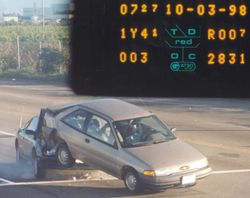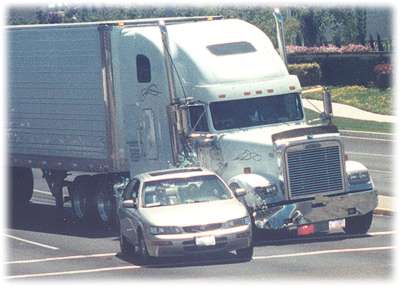Is it Intentional?
Office of the Majority Leader
U.S. House of Representatives

May 2001
|
The Red Light Running Crisis Is it Intentional? Office of the Majority Leader U.S. House of Representatives |  May 2001 |
|
The Report Summary 1. Something Funny 2. Camera Revenue 3. The Theory 4. The Fact 5. Code Changes 6. Cameras Ineffective 7. Conclusion 8. References Printed Copy (200k, PDF format) View the Documents |
Overview of U.S. Red Light Camera Studies
Jurisdictions that wish to claim safety as their motive for installing red light cameras will invariably cite studies that show the devices reduce red light running and the intersection collisions it causes. To date, the only case studies of red light running and camera use in the United States have taken place in Arlington, Virginia, City of Fairfax, Virginia and Oxnard, California. The studies performed at these locations share a lot in common, mostly because they were all performed by the same researcher. Consequently, they also share many of the same flaws in methodology. How to do a proper study: Australia One can see the flaws more clearly when they are contrasted with the 1995 Australian Road Research Board report, one of the most comprehensive looks at the effect of red light cameras to date. The report's conclusion is the most striking, particularly considering the American coverage of this issue: "There has been no demonstrated value of the RLC as an effective countermeasure" (page 1). And when one considers the study's methodology, one must also wonder why the same thoroughness is not found in Retting's American studies:
Red Light Cameras and Rear-end Accidents  The Australian study goes on to conclude that red light cameras tend to cause rear-end accidents. "This study suggests that the installation of the RLC at these sites did not provide any reduction in accidents, rather there have been increases in rear end and adjacent approaches accidents on a before and after basis�" (Page 20).
The Australian study goes on to conclude that red light cameras tend to cause rear-end accidents. "This study suggests that the installation of the RLC at these sites did not provide any reduction in accidents, rather there have been increases in rear end and adjacent approaches accidents on a before and after basis�" (Page 20).
This should come as no surprise. The goal of a red light camera is to make people fear being ticketed if they enter a camera-controlled intersection on red. Common sense dictates that if the desired effect of red light cameras is achieved, there will be an increase in rear-end accidents. This is because motorists fearing a ticket will panic and slam on their brakes to avoid entering an intersection. This sudden maneuver can surprise cars and trucks behind, causing a collision. The 2001 IIHS Oxnard accident study admits a connection between red light cameras and rear end accidents: Some additional rear-end crashes might result from non-uniform changes in driver behavior. For example, if drivers stop more often for red lights, they may be struck from behind by drivers not intending to stop. (2001 Oxnard study, page 2.)  One wonders if Retting considers perhaps that those same individuals are unable to stop, because of inadequate yellow time. The increase in rear-end accidents in this report are passed off as insignificant. But are they? These photos, found on the Oxnard, California police department website, were taken by red light cameras. They illustrate rear end collisions apparently caused by motorists panic-stopping. Yellow Light Timing As we have seen, yellow signal timing is fundamentally linked to red light entries. The 1999 Oxnard study concludes that since red light cameras were installed that there was a 40 percent reduction in red light violations at intersections with cameras, and a 50 percent reduction at intersections without cameras. But the study did nothing to document whether signal times, including yellow light times, were held constant throughout the duration of the research. There is reason to believe, based on the Australian findings, that the signal timings did in fact change during the study. Despite this, the author merely says that the times were "checked" and "deemed adequate": The duration of yellow traffic signal timing has been found to influence red light running at urban intersections (Retting and Greene, 1997). Therefore, yellow signal times at the camera sites were checked against an Institute of Transportation Engineers (1985) proposed recommended practice and were found to be adequate. (1999 Oxnard study.) The same language is used in the 1999 Fairfax and 2001 Oxnard studies. But, as discussed in Chapter 5 above, the 1985 proposed ITE yellow times can often be inadequate. It is reasonable to suspect they played a significant role in the red light entries that are documented in the report. But the 1985 proposed recommended practice was not followed. The proscribed countermeasure for excessive red light entries is an increase in the yellow signal time (page 6 of the 1985 ITE guidelines). This was not performed. And if it had been implemented, it is likely that the pro-camera conclusion of the reports would have been undermined. Moreover, if indeed the yellow time in the three studies was set to the numeric amounts resulting from the 1985 ITE practice, the excessive red light running that resulted tends to confirm the inadequacy of the yellow time from the practice itself. Actual red light accidents not studied in 2001 Oxnard report Incredibly, the 2001 IIHS Oxnard study did not actually study any accidents caused by red light running. "�the crash data did not contain sufficient detail to identify crashes that were specifically red light running events�" (2001 Oxnard report, page 1). Nor did it even study accidents at intersections that have red light cameras. Instead, the study's author, Retting, merely looked at accident codes from a database over a 2 and a half-year period to claim that accidents throughout the Oxnard area dropped by about 30 percent as a result of the red light cameras. The connection between area accidents and red light cameras is only an implied connection. There is no scientific evidence in the report showing any demonstrable connection between the two. That is why the 2001 report is entitled "Crash Reductions Associated With Red Light Camera Enforcement in Oxnard, California." Notice that it does not say, 'caused by.' But, nonetheless, the report is still used as a marketing tool to sell red light cameras. Drops in "violations" are no measure of success At times, jurisdictions that IIHS did not study will find other ways to "prove" the success of their red light camera program, particularly when they wish to order additional camera units. They simply cite the number of "citations" or "violations" at intersections. And they claim red light cameras are a success if there are any reductions. Of course, they fail to note that the number of both citations and violations given is entirely within the control of the camera operators. It's easy, for example, to turn off the camera for a period of time to achieve the desired number. The camera can be loaded with half a roll of film. Shifting the cameras around will alter the data. Cameras malfunction and are taken out of service for repairs. Signal timings, including lengthening the yellow, can happen without being reported. These are just a few of the many "tricks" or potential oversights available. It is clear, then, that the justifications given for red light camera installations are questionable. |
| Previous Page | Next Page |
|
Front Page | Get Updates |
Site Map |
About Us |
Search | TheNewspaper.com: Driving politics |
 |